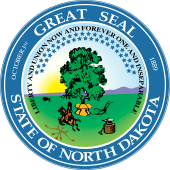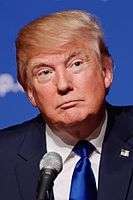United States presidential election in North Dakota, 2016
| | |||||||||||||||||||||||||||||||||||||||
| |||||||||||||||||||||||||||||||||||||||
| |||||||||||||||||||||||||||||||||||||||
|
| |||||||||||||||||||||||||||||||||||||||
| County Results
Clinton—50-60%
Clinton—60-70%
Trump—40-50%
Trump—50-60%
Trump—60-70%
Trump—70-80%
Trump—80-90% | |||||||||||||||||||||||||||||||||||||||
| |||||||||||||||||||||||||||||||||||||||
| Elections in North Dakota |
|---|
 |
The 2016 United States presidential election in North Dakota was held on November 8, 2016, as part of the 2016 General Election in which all 50 states plus The District of Columbia participated. North Dakota voters chose electors to represent them in the Electoral College via a popular vote pitting the Republican Party's nominee, businessman Donald Trump, and running mate Indiana Governor Mike Pence against Democratic Party nominee, former Secretary of State Hillary Clinton and her running mate, Virginia Senator Tim Kaine.
On June 7, 2016, as part of the Democratic Party presidential primaries, North Dakota voters expressed their preferences for the Democratic party's nominees for President. As North Dakota does not have a voter registration system,[1] all voters could choose to participate in this caucus. Due to a disagreement about the binding of delegates between state and national party leaders, no Republican Party primary or caucus was held. Instead, delegates were chosen at the state party convention April 1–3.[2]
Donald Trump won the election in North Dakota with 62.9% of the vote. Hillary Clinton received 27.2% of the vote.[3] The state also gave Libertarian Party candidate Gary Johnson his second best showing with 6.2% of the vote, only behind the 9.3% of the vote he received in his home state of New Mexico.
Primary elections
Democratic caucus
Three candidates appeared on the Democratic presidential primary ballot:
| North Dakota Democratic caucuses, June 7, 2016 | |||||
|---|---|---|---|---|---|
| Candidate | District delegates | State delegates | |||
| Count | Percentage | Pledged | Unpledged | Total | |
| Bernie Sanders | 253 | 64.21% | 13 | 1 | 14 |
| Hillary Clinton | 101 | 25.63% | 5 | 1 | 6 |
| Uncommitted | 40 | 10.15% | 0 | 0 | 0 |
| Total | 394 | 100% | 18 | 5 | 23 |
| Source: The Green Papers | |||||
Republican convention
The North Dakota Republican Party did not hold a presidential preference caucus or primary, but instead selected 28 Republican National Convention delegates unpledged to any particular candidate at the state party convention, which was held April 1–3, 2016.[2] A generally pro-Cruz slate of delegates was elected to the convention.[4] Cruz had the support of 14 delegates before he dropped out of the race. Three of them switched to Trump on May 27 along with all 13 of the uncommitted delegates giving Trump the majority of commitments and the support of 17 delegates (Trump had the support of 1 delegate before Cruz dropped out).
| North Dakota Republican state convention, April 1-3, 2016 | |||||
|---|---|---|---|---|---|
| Candidate | Actual delegate count | ||||
| Bound | Unbound | Total | |||
| 0 | 17 | 17 | |||
| Ted Cruz | 0 | 11 | 11 | ||
| John Kasich | 0 | 0 | 0 | ||
| (available) | 0 | 0 | 0 | ||
| Unprojected delegates: | 0 | 0 | 0 | ||
| Total: | 0 | 28 | 28 | ||
| Source: The Green Papers | |||||
Voting History
North Dakota joined the Union in November 1889 and has participated in all elections from 1892 onwards.
Since 1900, North Dakota voted Democratic 17.24 percent of the time and Republican 82.76 percent of the time.
Since 1968 the state has always voted for Republican and the same is expected to happen this time around as well.[5]
Analysis
Republican nominee Donald Trump won North Dakota in a 36-percentage-point-routing over Democratic rival Hillary Clinton, thus carrying the state's 3 electoral votes.[6] Like many neighboring majority-white, largely rural Great Plains and prairie states, North Dakota has not supported a Democratic candidate for president since Lyndon B. Johnson in 1964.
North Dakota politics are dominated by the farm, with a largely white and older populace who are socially conservative. Though the state's farming population has briefly flirted with populism, that movement is now mostly faded from North Dakota politics, as farms in North Dakota are no longer tilled by solitary yeoman and are no longer family-owned as much, and are replaced by agribusinesses.[7]
In recent Presidential elections, Bakken shale oil has been a major driver of conservative success in the state, as its economy is increasingly fueled by the North Dakota oil boom and its population grows suspect of the environmental movement championed by Democrats. The main oil boom has taken place in the counties west and northwest of Bismarck, where Donald Trump won sometimes north of 80% of the vote.[8]
Donald Trump won in Grand Forks County which contains the city of Grand Forks, in Cass County which contains the city of Fargo, and in Burliegh County which contains the capital city of Bismarck. He also swept most of the rural and deeply conservative counties of the state, sometimes taking more than 80% of the vote in a county. Clinton won resoundingly in Sioux County, which is majority Native American and is the site of the Dakota Access Pipeline Protest by its inhabitants, the Sioux Indian tribe.
See also
- Democratic Party presidential debates, 2016
- Democratic Party presidential primaries, 2016
- Republican Party presidential debates, 2016
- Republican Party presidential primaries, 2016
References
- ↑ Jaeger, Alvin. "North Dakota….The Only State Without Voter Registration" (PDF).
- 1 2 Nowatzki, Mike. "With ND Republicans unable to cast votes for presidential nominee, Cramer launches online straw poll". Forum of Fargo-Moorhead. Retrieved 26 February 2016.
- ↑ http://www.nytimes.com/elections/results/north-dakota
- ↑ http://www.thegreenpapers.com/P16/ND-R
- ↑ North Dakota Presidential Election 2016 Results LIVE Updates
- ↑ "North Dakota Election Results 2016". Retrieved 2016-11-12.
- ↑ Cohen, Micah (2012-10-14). "An Extra Ingredient in North Dakota Politics: Oil". FiveThirtyEight. Retrieved 2016-11-12.
- ↑ Cohen, Micah (2012-10-14). "An Extra Ingredient in North Dakota Politics: Oil". FiveThirtyEight. Retrieved 2016-11-12.
External links
- RNC 2016 Republican Nominating Process
- Green papers for 2016 primaries, caucuses, and conventions
- 2016 Presidential primaries, ElectionProjection.com




